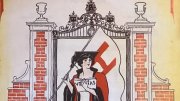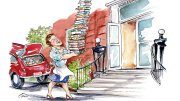The April 27 issue of the New Yorker featured an in-depth exploration, by Elif Batuman ’99, of the journey a set of church bells from Russia's Danilov Monastery to Harvard and back again. (To read the article, start with the abstract here, then either log in or register with the site to get the full text.)
Batuman lived in Lowell House as an undergraduate and has less-than-fond memories of the bells—for instance, the "peculiarly tuneless variations on melodies like 'Twinkle, Twinkle, Little Star'" played by the Lowell House Klappermeisters on Sunday afternoons.
But a decade (and a doctoral dissertation in comparative literature) later, she finds herself delving deep into the bells' history. She probes their meaning in Russian culture, stretching all the way back to the eleventh century and supporting her claims with literary references. She tells the oddly poignant story of Konstantin Saradzhev, the young Russian who came to Lowell House in 1930 to oversee the bells' installation. And she quotes Lowell House master Diana Eck, among other Harvard figures mentioned, on the complicated process of returning the bells.
Businessman and philanthropist Charles R. Crane, LL.D. ’22, bought the bells and gave them to Harvard to save them from being melted down, the sad fate that many other historic bells met as Soviet authorities dismantled places of worship. On March 17, the bells were rung for the first time since their return to their original home.
Hear Batuman discuss her article in this podcast (which also includes the sound of the bells themselves). Visit Batuman's blog for additional related links and a behind-the-scenes account of what it's like to write for the New Yorker.
Read Harvard Magazine's account of the bells' removal from Lowell House last summer (with photographs) here; for previous coverage, see these items in the magazine's College Pump column:








